For college football fans, it’s been an interminably long wait since NCAA Football 14. As debates about student athletes getting paid hastened the demise of EA’s NCAA Football series, the ensuing void left many feeling a little like Reggie Bush wondering where his Heisman went. But just as Reggie’s Heisman situation worked itself out thanks to three little letters (NIL), EA has leveraged the shifting winds of opinion on the issue to resurrect its series with EA Sports College Football 25.
It’s a welcome return that revels in recreating the details that make football at this level so special. From the roar of a raucous packed house mingling with the marching band’s school fight song to the high-scoring shootouts fueled by gadget offenses picking apart defenses that offer little resistance, this is nothing if not an affectionate tribute to the sport.
The natural concern that the game would be little more than a re-skinned Madden 24 proves to be both warranted yet overblown. It certainly follows in its footsteps on the field, where the games share an engine, but it makes the sort of improvements over Madden 24 that we don’t always get year over year with annual releases. Reworked passing mechanics and better control of ball-carriers are just a couple of highlights to the gameplay, but don’t sleep on the introduction of a promising new kicking meter.
EA Sports College Football 25 carves out its own identity and separates itself most from Madden off the field where the game’s dynasty mode captures the strategic intricacies of trying to recruit high school players and shepherd their raw talent to greatness. Dynasty is made even better thanks to Team Builder (bugs and all) providing you the opportunity to customize your school’s logo, uniforms, stadiums, and more.
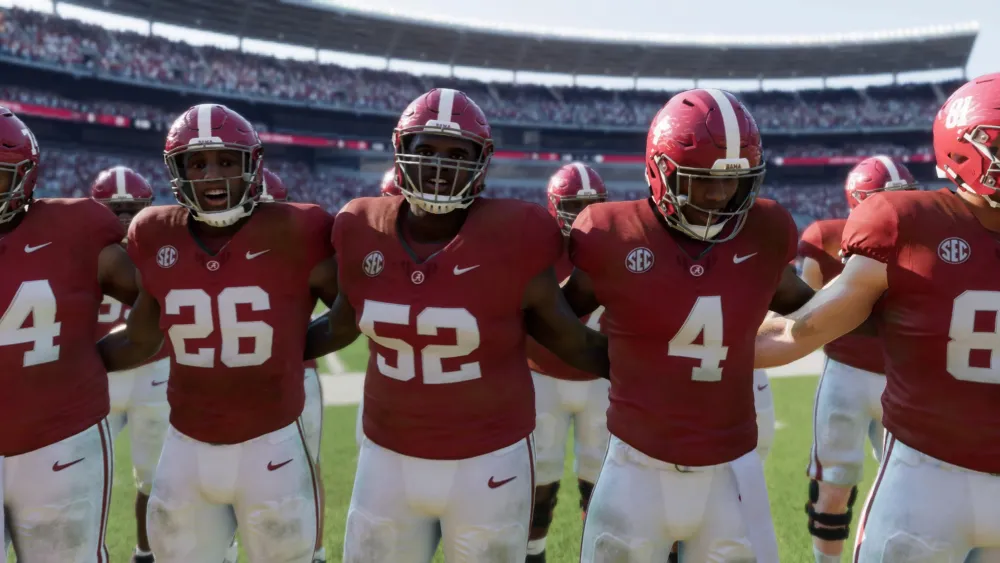
However, it’s hardly surprising that EA Sports College Football 25 falters in some of the same areas where Madden has habitually come up short. The career mode, Road To Glory, suffers from the sort of design flaws that have plagued Madden’s similar Superstar mode in recent years. It saps much of the excitement of excelling at a position like running back or wide receiver by keeping you off the field during pivotal moments of a game and limiting your ability to adjust your coach’s atrocious play-calling. Ultimate Team, the game’s obligatory card-collecting mode borrows its playbook directly from Madden, right down to the endless challenges within Field Passes and the necessity to spend real money if you want to ensure that you have the best cards available.
All that said, let’s venture through the transfer portal and closely examine where the game looks like an elite prospect that’s destined to be a high draft pick in the pros and where it could use another year of eligibility or two to work on its shortcomings.
What I Like
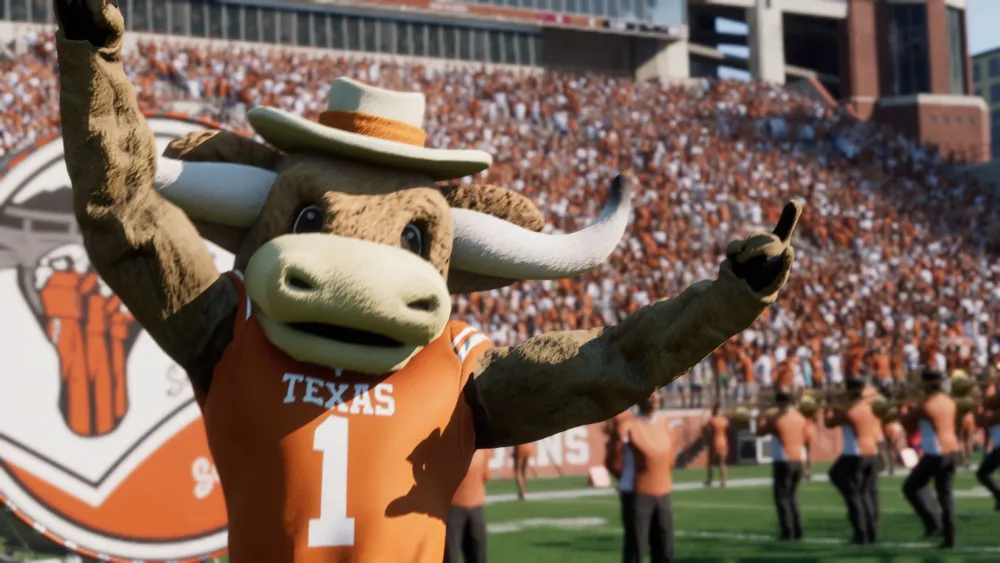
Presentation
A central challenge for EA Sports College Football 25 is to conjure the same kind of electric atmosphere that you see regularly on Saturdays and its effort here is admirable. That starts with the massive crowds that fill the biggest stadiums in the country and stir up such a commotion that the game is smart to bring back on-screen meters that measure their energy level. Close-up shots pick out individual fans within the chaos, and for the most part it’s enough of a spectacle to feel the sea of colors undulating together in the background. The marching bands that move in tandem on the field during pregame festivities and punctuate consequential moments in the game with the familiar strains of a team’s fight song serve to keep you immersed in the bustling environment. There has clearly been a great deal of care invested in ensuring that every team represented has specific emblems, mascots, and stadium features that their fans will be able to recognize and appreciate.
The same flashy TV-broadcast style that builds excitement at the outset of every game with shots of the home team storming triumphantly onto the field continues to inject a palpable sense of intensity after the kickoff as well. Replays from a variety of angles are cued up following game-changing plays just as you would hope, even utilizing an effective picture-in-picture view while you are calling your next play to show what happened on the previous one. There’s a steady stream of stats after plays too that help keep you abreast of how players are doing pretty much whenever someone throws, carries, or catches the ball (albeit those sorts of stats during the on-field gameplay are curiously absent).
The commentary teams that include names like Kirk Herbstreit and Jesse Palmer can come off a little bit repetitive and stilted at times (the A-team of Herbstreit and Fowler is clearly much worse both in quality of audio and what they’re saying), but that’s pretty much what we’ve come to expect from the commentary in Madden games at this point (plus you can always just turn it off anyway).
There’s so much more room to grow here in terms of more camera angles and wide shots to appreciate the stadiums and crowds, improved commentary, and better overall TV-style presentation, but in terms of atmosphere and tradition — areas where it had to succeed — most everything pops.
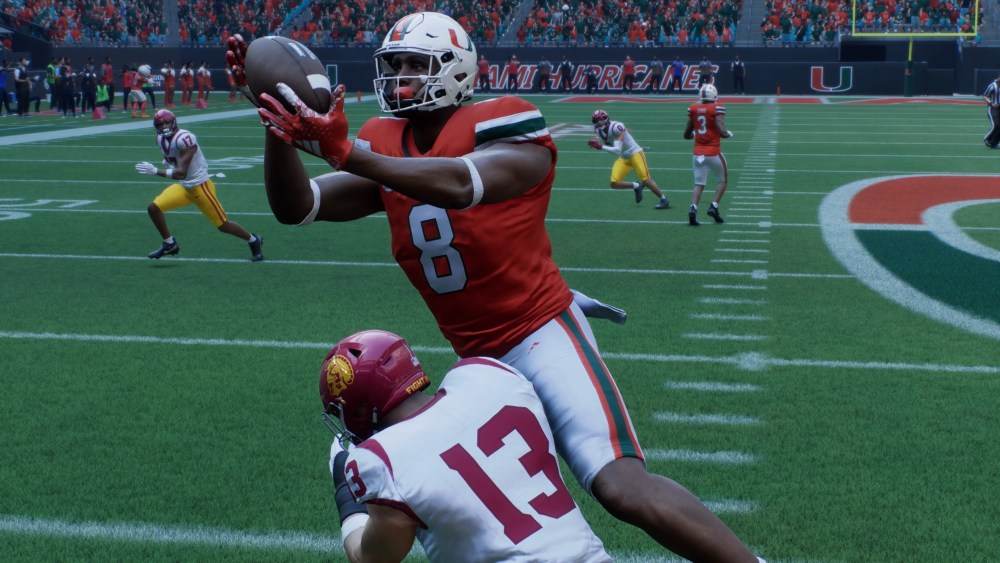
Gameplay
If you’ve played a lot of Madden 24, the gameplay isn’t going to be all that ground-breaking in some respects, but there are some differences and innovations that make it ultimately feel like a noticeable upgrade. Revamped Passing allows you more influence on the trajectories of the ball, and coupled with the different skill levels of quarterbacks, this leads to more dynamic ball placements from throw to throw. If you want to return to Placement & Accuracy, it might still be the “better” option for the highest skill level, but that EA has implemented two viable passing systems is a big accomplishment for a sport where it has always struggled to balance various passing systems at once.
With that in mind, one of the stranger omissions is the lack of a tutorial system that meets the moment. Madden has actually done great work with tutorials the last couple years, and there’s no doubt the amount of new players is through the roof for this game. And though you can always hone your grasp of attacking through the air in open practice or mini-games, you’re still left wishing there was some kind of tutorial that walked you through the intricacies of manipulating the passing meter, offensive line adjustments, defensive coverages, and so much more.

Running the ball is more fun and intuitive than in Madden 24 for a number of reasons. It’s easier to make cuts and alter your direction using the left stick at the outset of any runs, allowing you to identify the holes in the defense and then hit them hard. Speaking of those holes, the offensive line generally shows good awareness in locking up defenders and a new pre-play option is invaluable by displaying each of your lineman’s assignments on any given play. In the open field, the jukes at your disposal can seem downright diabolical at times in evading defenders and stringing together a finesse move with a brutal stiff arm is undeniably satisfying. Then there are the playbooks that lean heavily on option plays and can keep your opponent on their heels with all manner of RPOs, well-timed pitches, and QB keepers. Overall, the new playbooks really are the star of the show and help to highlight all the new open-field chaos you can get into now.
As you might expect from a college football game, the hardest aspect to master is defense. Slowing down elite offenses that boast potent weapons, especially when you’re controlling a school that doesn’t have a lot of depth on that side of the ball, can be an exercise in futility. Inept defenders will feel especially sluggish and struggle to make tackles in space or hold up in coverage. It doesn’t help either that they will often stray from their assigned zones, leaving receivers as wide open as you have ever seen on a football field. While this kind of broken coverage logic is what breeds the sort of money plays that have plagued Madden for years, it also creates exhilarating back-and-forth shootouts that are more commonplace at the college level. Rather than trying to pitch a shutout in a game, getting a single stop in a pivotal moment can mean the difference then between victory and defeat.
Still, we have to at least mention how bad the pursuit angles are in the game. New coverage shells, and mixing and matching zones means playcalling can get you further than it used to even if the players let you down at times with their coverage assignments during a play, but there’s not a great way to plan for defenders taking terrible pursuit angles while approaching ball carriers. Even with the fantastic new Switch Stick, there’s only so much you can do at times to make up for AI defenders taking the wrong line on the way to trying to make a play.
On special teams, the game introduces a kicking meter that goes a long way towards bringing some realism to an oft-overlooked yet vital component of the sport (it is called “foot”ball, after all). The 3-click method that Madden has used for many years now has clearly proven to be too easy to master, especially when it comes to the accuracy of field goals. The whole process has been simplified to only one click now, but it’s harder than you might expect to keep the ball straight. You need to time that one click carefully and that’s increasingly difficult when you’re lining up a lengthy field goal and working with a kicker who definitely isn’t going to be appearing on NFL draft boards any time soon.
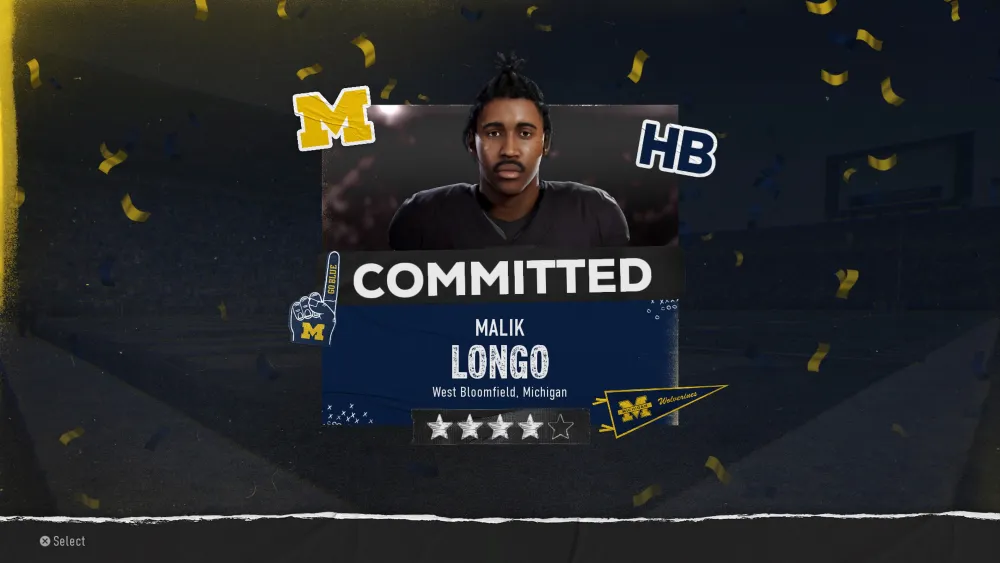
Dynasty
Without question, the game’s standout mode is Dynasty, where you’re able to coach your preferred college team over the course of multiple seasons, grasping for supremacy within your conference and hunting the elusive opportunity to play in the CFB Playoffs (or, failing that, at least in a bowl game). Creating and customizing a coach doesn’t offer quite enough options, which becomes more of an issue with the gear and style of your coach than with their physical appearance. Standout matchups against rival schools within the conference or area are given sufficient fanfare, allowing you to stay connected to the emerging storylines surrounding your team and around the nation.
Even more so than in real life, the weekly rankings of colleges throughout a season can be a little wonky though, and it’s always disappointing to see teams with inferior records being ranked higher than those racking up more impressive wins. Other items like wonky simulated stats, an overabundance of upsets, progression getting out of hand as years progress in your dynasty, and a lack of certain roster editing tools are all things that can be pointed to as areas for improvement either in patches or for next year.
A crucial part of dynasty mode is recruiting high school players to commit for your college, which is a complex and rewarding mini-game in its own right. You start by combing over prospects and devoting your currency of time to scouting their abilities, deciding who’s deserving of the limited number of scholarships you have to offer. You can help grease the wheels with coveted prospects by showering them with attention, scheduling visits to your school, and making hard or soft pitches. All players have their different priorities, however, and they will eventually base their decision on where to play on such factors as playing time, school history, and if they can stay close to home. When you’re successfully able to outfox other schools and lure a promising talent to your school, there’s no doubt that it makes you all the more invested in their future on your team.
People will point to the aforementioned bugs/missing features like the simulated stats being unrealistic, but the thing to point to here for the future is the presentation. As much enjoyment as there is sinking time into recruiting, coaching trees, and the new transfer portal, there’s a lot of “juice” that could be added into the mode. Whether it’s old things like a trophy room returning, or just giving us more flavor around big upsets or national signing day, this is the real area dynasty mode could attack next year in order to make everything feel more alive.
Regardless, it all works well as a single-player offline experience, but it’s even better when you join an online dynasty with other teams being coached by people. Trying to coax a high school player away from a CPU’s rival school just isn’t quite the same as narrowly beating out the pitch of a friend of yours and then notching an on-field victory against that friend on the back of the recruit you had both wanted. The shorter seasons than in a Madden 24 franchise also helps to cut down on inevitable quitters during losing seasons since it’s easier for them to believe that better days are just around the corner next season if only they can land a few impactful recruits.
Team Builder
Whether you decide to spend most of your time in an online or offline dynasty, the mode’s Team Builder customization suite that can be accessed online allows you a lot of freedom in how you want your school’s team to look whenever they suit up and take the field. It’s genuinely surprising to learn that this is a returning feature from EA’s older NCAA titles because it can’t help but expose how the company let a wonderful idea fall by the wayside in Madden games. This revived version gives you an almost overwhelming amount of control over the look of your team, including the ability to alter your school’s name, stadium, logos, uniforms, and preferred brands. You’re even able to edit the physical appearance, name, size, and abilities of the players that comprise the team.
It’s almost all of the tools needed to start creating an entire universe of your own invention across the landscape of college football — if only you weren’t constrained by the amount of teams you can use. There are some definite bugs here, and the website is still shaky at times, but this is a clear winner of a mode that just needs to be added to now.
What I Don’t Like

Road To Glory
One day EA might get a career mode right. You’d really think by now that EA would have a better grasp of what people want from a career mode, but they just can’t seem to get out of their own way. All we really want is a big sandbox to play in, and yet they keep watering it down to the point that it’s nothing but mud. How else to explain the manner in which the game’s career mode, Road To Glory, appears committed to deliberately keeping you out of exciting moments on the field? As a receiver or running back, you’ll be deprived of the chance to develop quickly by having to sit out far too many plays on the sideline while the games are decided without you. Nobody is longing to ride to the bench in a video game — it should be a no-brainer to throw you into the fray from the outset so can you start logging snaps on a regular basis.
Your coach is also bad at calling plays (for all the credit given to the expanded playbooks this year, the “suggestions” from your coach for what plays to call remain disappointing in all modes). While you do have the ability to change a certain number of plays during the game, your three options will usually include the very same play that’s just been called that you’re trying to change. The way that you can choose to develop your player by devoting energy to different areas week-to-week doesn’t yield results that are presented in any meaningful way. The storylines that unfold in stagnant text-message exchanges between your player and various figures in his orbit are perfunctory and the method of presentation is dated.
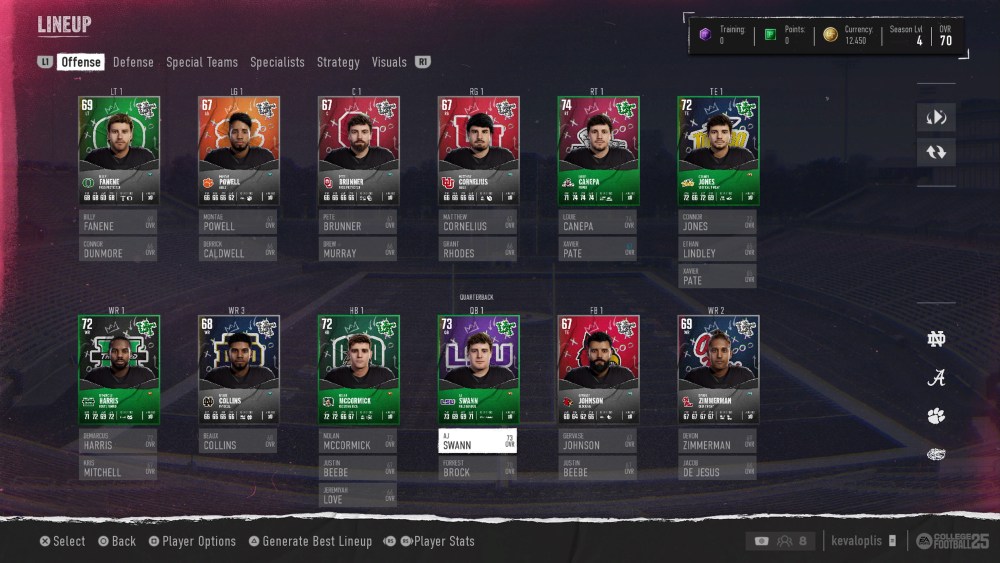
Ultimate Team
It would have been so refreshing if EA Sports College Football 25 had lofty ambitions to re-imagine what a card-collecting mode could be, but it opted instead to stick depressingly close to the tired formula long established now by Madden games. That means you’ll have to invest some real money to purchase the mode’s best cards or devote an inordinate amount of time slogging through series after series of repetitive challenges if you want to field a halfway decent squad that can compete online without shelling out a dime.
Some might enjoy the depth involved in completing objectives to progress Field Passes that reward you for completing sets, and buying packs, and purchasing abilities, and on and on and on. For the more casual player, it quickly becomes exhausting and has you feeling a little like Sisyphus trying to roll that boulder up the hill every day.

Bottom Line
EA Sports College Football 25 succeeds in scratching the itch that had been nagging football fans for just over a decade by delivering a solid, if not quite perfect, return to the world of college football. In terms of things it simply could not “miss” on in year one, it almost always delivers.
The presentation is stellar in the way it transports you to faithful renderings of every school’s stadium, allowing you to bask in the palpable and unique atmosphere of gameday at various locales. The gameplay isn’t drastically different than Madden 24, but its upgrades are impactful, giving you command of powerful offensive playbooks and tactics while also introducing an inventive new kicking meter. In other words, it feels better than Madden in many ways while finding its own identity along the way.
Dynasty mode emerges as the game’s centerpiece by tasking you with making crucial decisions for a school’s team over the course of many seasons as players go from being recruited in high school to being drafted by an NFL team. Dynasty is made even better thanks to Team Builder, which lets your creativity flourish in designing all aspects of your team’s aesthetics and lineup.
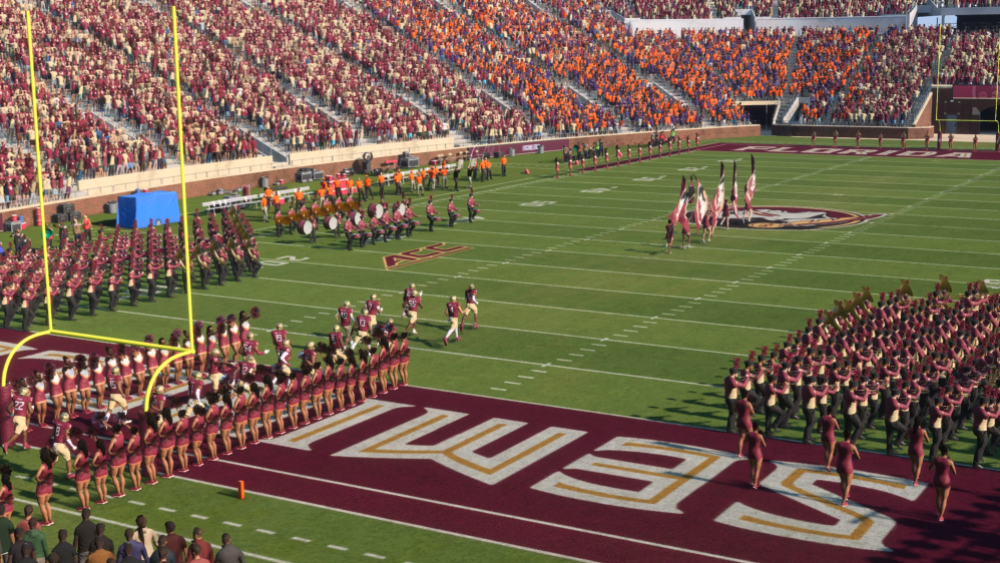
The game stumbles though when it insists on remaining in the shadow of Madden, bearing the same frustrating flaws and ethos that continue to hold that series back from greatness. Road To Glory, the game’s player career mode, doesn’t get you on the field enough early in your college career at some positions to have you invested in your team’s games and its progression system is slow on dishing out incentives and tangible rewards for your efforts. The game’s Ultimate Team mode leans on the same framework, redundancy, and outright greed that forms the foundation for the one that’s all too familiar at this point to those who play Madden.
Zooming out, College Football 25 just lacks a bit of character and depth in ways that don’t involve the pageantry itself. Everything from dynasty mode to the TV-style presentation should all benefit from another year where EA can hopefully get a little more in the weeds and add more personal touches and fix glaring issues that will hurt the longevity of the game this year.
All in all, that its depth isn’t quite there is more understandable when considering this is the return of the series. It’s a home that’s being rehabbed from 2013. The outside looks great now, but the master bathroom and the kitchen still need to be updated to match where we’re at now in 2024.











Published: Jul 29, 2024 11:18 PM UTC